Singapore Airlines: Success Factors
VerifiedAdded on 2020/05/16
|11
|3202
|103
AI Summary
This assignment delves into the key factors contributing to the success of Singapore Airlines. It examines their robust business strategy, operational efficiency measures, and commitment to exceptional customer service. The analysis draws upon various academic sources and industry reports to provide a comprehensive understanding of what makes Singapore Airlines a global leader in the aviation industry.
Contribute Materials
Your contribution can guide someone’s learning journey. Share your
documents today.
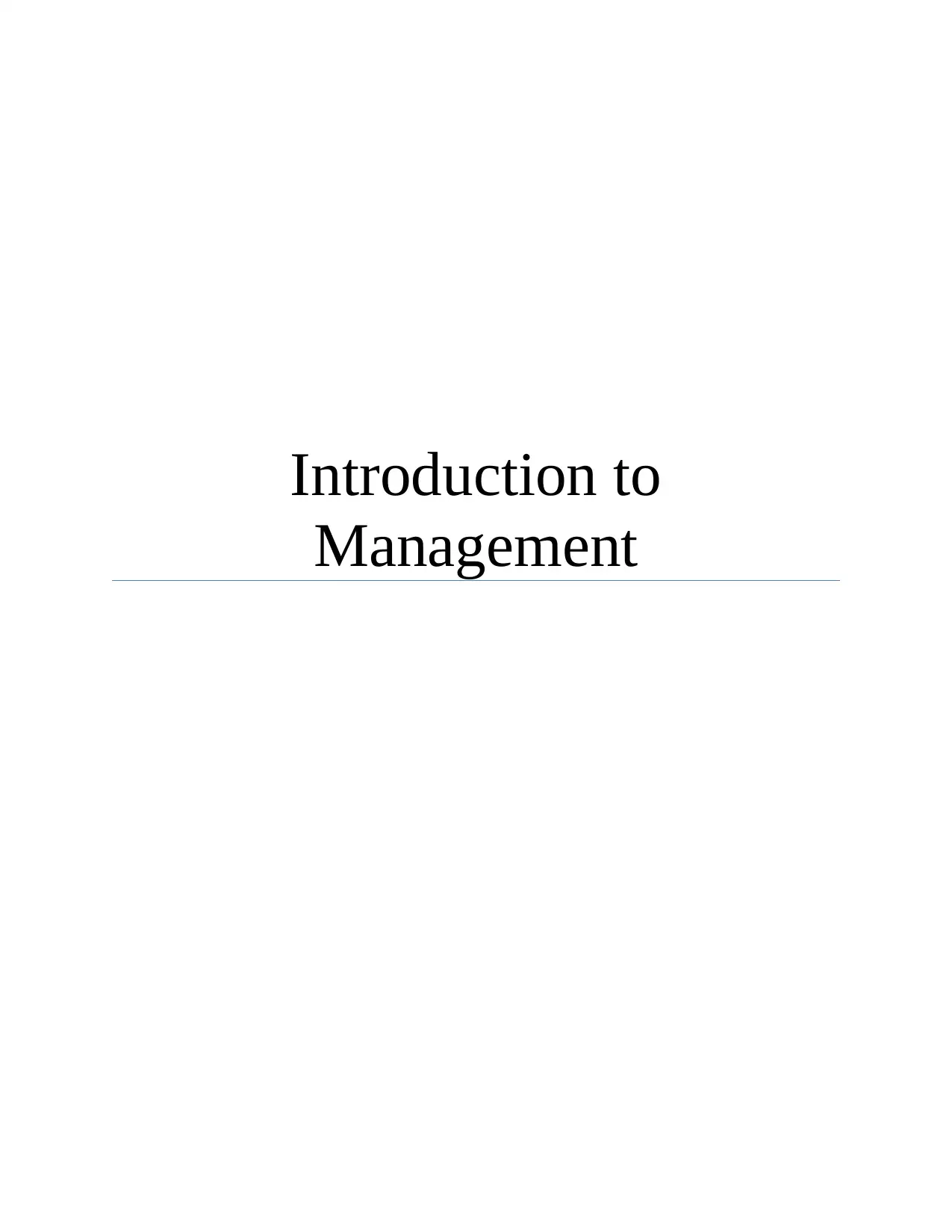
Introduction to
Management
Management
Secure Best Marks with AI Grader
Need help grading? Try our AI Grader for instant feedback on your assignments.

1
Contents
Purpose 2
Introduction of Company 2
External Environment Analysis 3
PESTLE Analysis 3
Porter’s 5 Forces 5
Issue Analysis 7
Recommendations 7
Conclusion 8
References 9
Contents
Purpose 2
Introduction of Company 2
External Environment Analysis 3
PESTLE Analysis 3
Porter’s 5 Forces 5
Issue Analysis 7
Recommendations 7
Conclusion 8
References 9
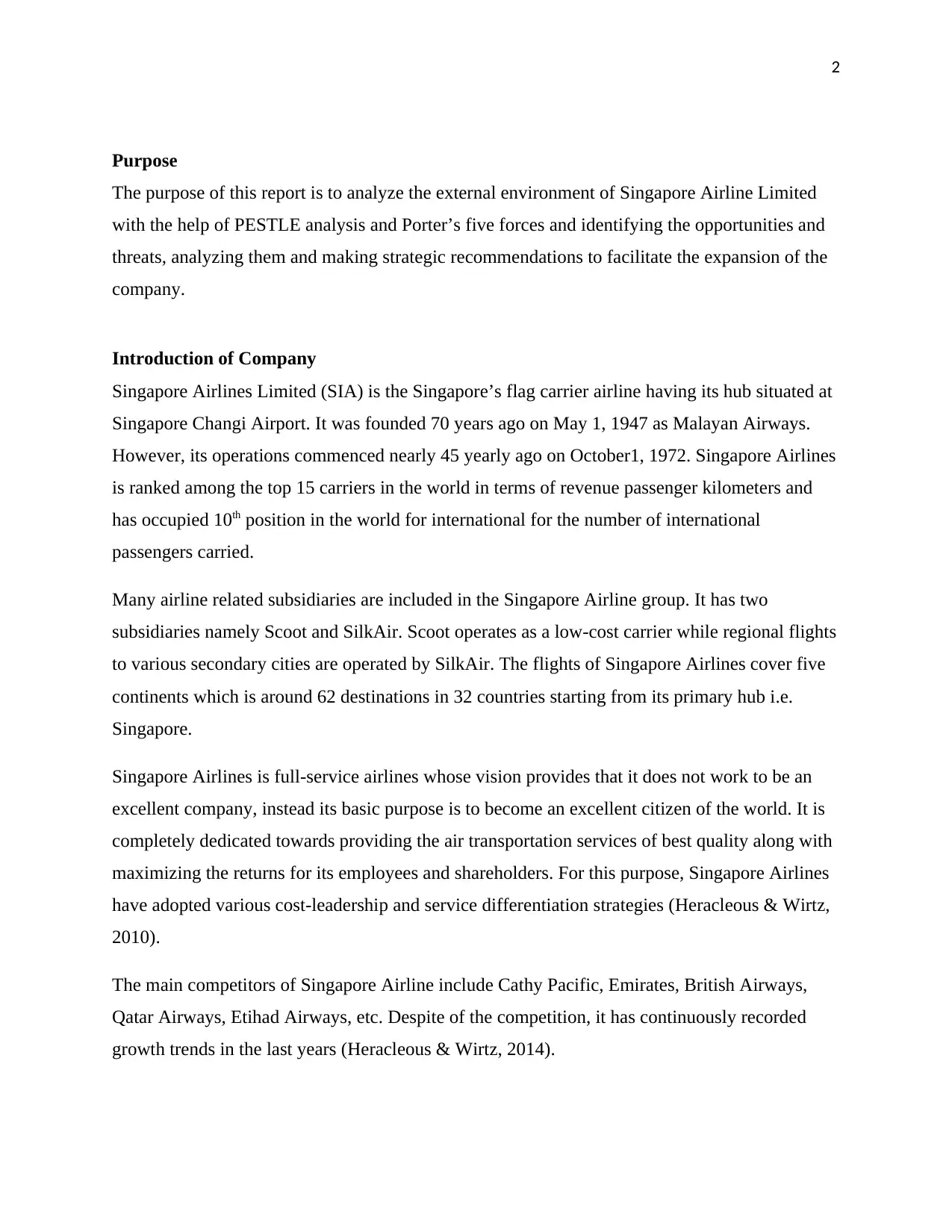
2
Purpose
The purpose of this report is to analyze the external environment of Singapore Airline Limited
with the help of PESTLE analysis and Porter’s five forces and identifying the opportunities and
threats, analyzing them and making strategic recommendations to facilitate the expansion of the
company.
Introduction of Company
Singapore Airlines Limited (SIA) is the Singapore’s flag carrier airline having its hub situated at
Singapore Changi Airport. It was founded 70 years ago on May 1, 1947 as Malayan Airways.
However, its operations commenced nearly 45 yearly ago on October1, 1972. Singapore Airlines
is ranked among the top 15 carriers in the world in terms of revenue passenger kilometers and
has occupied 10th position in the world for international for the number of international
passengers carried.
Many airline related subsidiaries are included in the Singapore Airline group. It has two
subsidiaries namely Scoot and SilkAir. Scoot operates as a low-cost carrier while regional flights
to various secondary cities are operated by SilkAir. The flights of Singapore Airlines cover five
continents which is around 62 destinations in 32 countries starting from its primary hub i.e.
Singapore.
Singapore Airlines is full-service airlines whose vision provides that it does not work to be an
excellent company, instead its basic purpose is to become an excellent citizen of the world. It is
completely dedicated towards providing the air transportation services of best quality along with
maximizing the returns for its employees and shareholders. For this purpose, Singapore Airlines
have adopted various cost-leadership and service differentiation strategies (Heracleous & Wirtz,
2010).
The main competitors of Singapore Airline include Cathy Pacific, Emirates, British Airways,
Qatar Airways, Etihad Airways, etc. Despite of the competition, it has continuously recorded
growth trends in the last years (Heracleous & Wirtz, 2014).
Purpose
The purpose of this report is to analyze the external environment of Singapore Airline Limited
with the help of PESTLE analysis and Porter’s five forces and identifying the opportunities and
threats, analyzing them and making strategic recommendations to facilitate the expansion of the
company.
Introduction of Company
Singapore Airlines Limited (SIA) is the Singapore’s flag carrier airline having its hub situated at
Singapore Changi Airport. It was founded 70 years ago on May 1, 1947 as Malayan Airways.
However, its operations commenced nearly 45 yearly ago on October1, 1972. Singapore Airlines
is ranked among the top 15 carriers in the world in terms of revenue passenger kilometers and
has occupied 10th position in the world for international for the number of international
passengers carried.
Many airline related subsidiaries are included in the Singapore Airline group. It has two
subsidiaries namely Scoot and SilkAir. Scoot operates as a low-cost carrier while regional flights
to various secondary cities are operated by SilkAir. The flights of Singapore Airlines cover five
continents which is around 62 destinations in 32 countries starting from its primary hub i.e.
Singapore.
Singapore Airlines is full-service airlines whose vision provides that it does not work to be an
excellent company, instead its basic purpose is to become an excellent citizen of the world. It is
completely dedicated towards providing the air transportation services of best quality along with
maximizing the returns for its employees and shareholders. For this purpose, Singapore Airlines
have adopted various cost-leadership and service differentiation strategies (Heracleous & Wirtz,
2010).
The main competitors of Singapore Airline include Cathy Pacific, Emirates, British Airways,
Qatar Airways, Etihad Airways, etc. Despite of the competition, it has continuously recorded
growth trends in the last years (Heracleous & Wirtz, 2014).

3
External Environment Analysis
PESTLE Analysis
Political
The airline industry is majorly impacted by the national political frameworks due to the
excessive control of the authorities despite being deregulated. The competition landscape and the
industry profitability are impacted due to the development of the industry because of favorable
government policies. Singapore is considered among politically stable countries. According to
Political and Economic Risk Consultancy (PERC), Singapore faces lowest political risk in the
continent. Singapore is a democratic country where the leaders of the nation are elected by the
people. This independence leads to political stability in the country thereby leading to peace and
improved standard of living in the country. The Liberal Aviation Policy provides a degree of
stability to the Singapore aviation. As it’s open sky policy has helped country to grow as a key
air hub. It provides liberal framework for air services and cities which are linked to the country. The
lasting influence of the government policies and force on the airline industry must be clearly
recognized by all the players of the industry while embracing market liberalization. The failure
to follow can put the Singapore Airlines in trouble and engage them in various suits. For
example, the falling prices of oil in earlier years resulted in extreme pressure for the airline to
reduce price of tickets. (Today, 2016).
Economic
The airline industry is linked with the regional, national and international development of the
economy and therefore the airline industry is affected by the economic environment. Singapore
is a free market economy which has the highest per-capita income in ASEAN. The business
sector is supported by the corruption-free environment. And the financial and legal framework
assists the business in effective functioning. The government plays an active role and owns
substantial productive assets. Recently, the economy has been diversified by the government.
Interest rates, crude oil prices, growth in GDP and peak and trough of the economic cycle impact
the airline industry by lifting the input costs of the industry. According to the results of the
research of International Air Transport Association (IATA), there is considerable growth in the
disposable income of the people which has subsequently resulted in the growth of GDP which
External Environment Analysis
PESTLE Analysis
Political
The airline industry is majorly impacted by the national political frameworks due to the
excessive control of the authorities despite being deregulated. The competition landscape and the
industry profitability are impacted due to the development of the industry because of favorable
government policies. Singapore is considered among politically stable countries. According to
Political and Economic Risk Consultancy (PERC), Singapore faces lowest political risk in the
continent. Singapore is a democratic country where the leaders of the nation are elected by the
people. This independence leads to political stability in the country thereby leading to peace and
improved standard of living in the country. The Liberal Aviation Policy provides a degree of
stability to the Singapore aviation. As it’s open sky policy has helped country to grow as a key
air hub. It provides liberal framework for air services and cities which are linked to the country. The
lasting influence of the government policies and force on the airline industry must be clearly
recognized by all the players of the industry while embracing market liberalization. The failure
to follow can put the Singapore Airlines in trouble and engage them in various suits. For
example, the falling prices of oil in earlier years resulted in extreme pressure for the airline to
reduce price of tickets. (Today, 2016).
Economic
The airline industry is linked with the regional, national and international development of the
economy and therefore the airline industry is affected by the economic environment. Singapore
is a free market economy which has the highest per-capita income in ASEAN. The business
sector is supported by the corruption-free environment. And the financial and legal framework
assists the business in effective functioning. The government plays an active role and owns
substantial productive assets. Recently, the economy has been diversified by the government.
Interest rates, crude oil prices, growth in GDP and peak and trough of the economic cycle impact
the airline industry by lifting the input costs of the industry. According to the results of the
research of International Air Transport Association (IATA), there is considerable growth in the
disposable income of the people which has subsequently resulted in the growth of GDP which
Secure Best Marks with AI Grader
Need help grading? Try our AI Grader for instant feedback on your assignments.
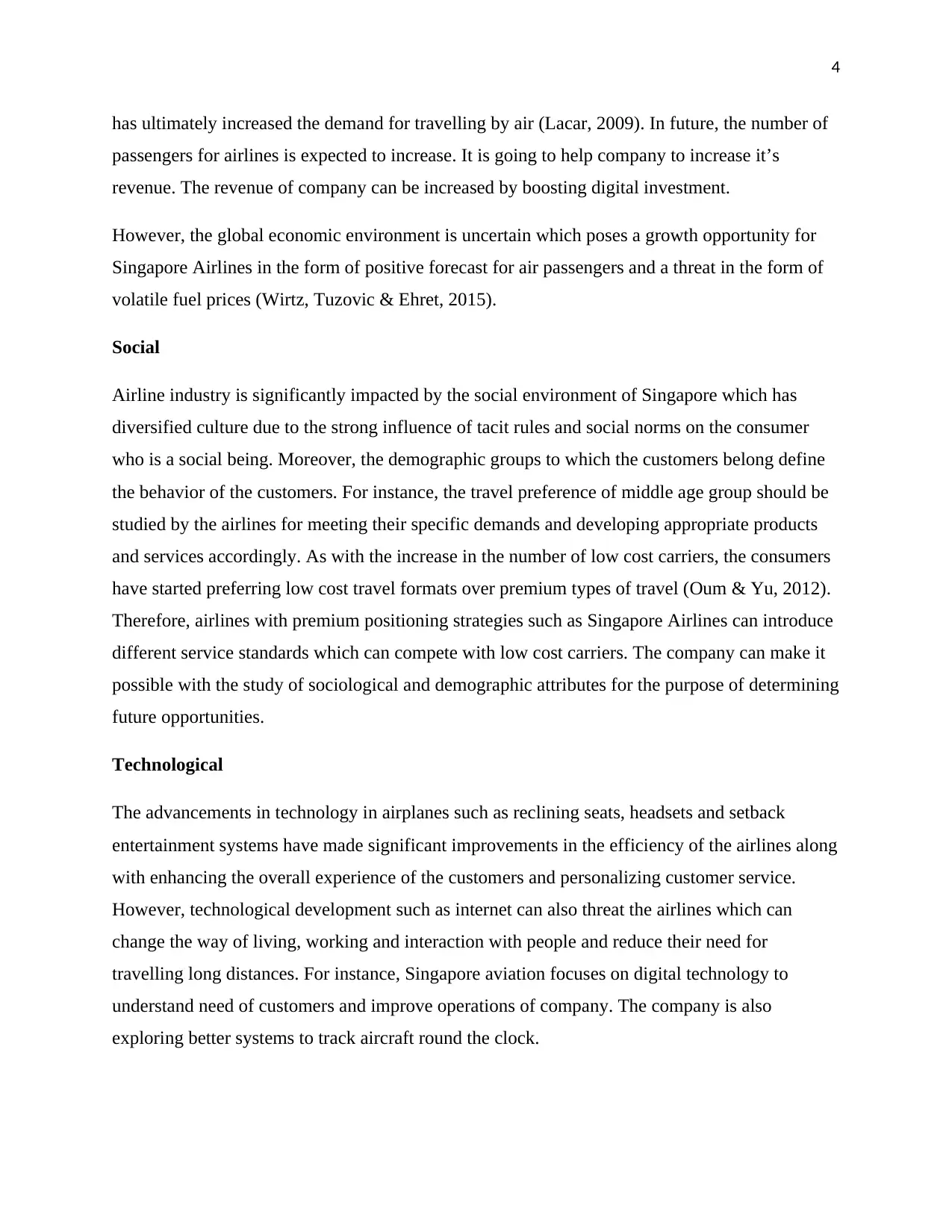
4
has ultimately increased the demand for travelling by air (Lacar, 2009). In future, the number of
passengers for airlines is expected to increase. It is going to help company to increase it’s
revenue. The revenue of company can be increased by boosting digital investment.
However, the global economic environment is uncertain which poses a growth opportunity for
Singapore Airlines in the form of positive forecast for air passengers and a threat in the form of
volatile fuel prices (Wirtz, Tuzovic & Ehret, 2015).
Social
Airline industry is significantly impacted by the social environment of Singapore which has
diversified culture due to the strong influence of tacit rules and social norms on the consumer
who is a social being. Moreover, the demographic groups to which the customers belong define
the behavior of the customers. For instance, the travel preference of middle age group should be
studied by the airlines for meeting their specific demands and developing appropriate products
and services accordingly. As with the increase in the number of low cost carriers, the consumers
have started preferring low cost travel formats over premium types of travel (Oum & Yu, 2012).
Therefore, airlines with premium positioning strategies such as Singapore Airlines can introduce
different service standards which can compete with low cost carriers. The company can make it
possible with the study of sociological and demographic attributes for the purpose of determining
future opportunities.
Technological
The advancements in technology in airplanes such as reclining seats, headsets and setback
entertainment systems have made significant improvements in the efficiency of the airlines along
with enhancing the overall experience of the customers and personalizing customer service.
However, technological development such as internet can also threat the airlines which can
change the way of living, working and interaction with people and reduce their need for
travelling long distances. For instance, Singapore aviation focuses on digital technology to
understand need of customers and improve operations of company. The company is also
exploring better systems to track aircraft round the clock.
has ultimately increased the demand for travelling by air (Lacar, 2009). In future, the number of
passengers for airlines is expected to increase. It is going to help company to increase it’s
revenue. The revenue of company can be increased by boosting digital investment.
However, the global economic environment is uncertain which poses a growth opportunity for
Singapore Airlines in the form of positive forecast for air passengers and a threat in the form of
volatile fuel prices (Wirtz, Tuzovic & Ehret, 2015).
Social
Airline industry is significantly impacted by the social environment of Singapore which has
diversified culture due to the strong influence of tacit rules and social norms on the consumer
who is a social being. Moreover, the demographic groups to which the customers belong define
the behavior of the customers. For instance, the travel preference of middle age group should be
studied by the airlines for meeting their specific demands and developing appropriate products
and services accordingly. As with the increase in the number of low cost carriers, the consumers
have started preferring low cost travel formats over premium types of travel (Oum & Yu, 2012).
Therefore, airlines with premium positioning strategies such as Singapore Airlines can introduce
different service standards which can compete with low cost carriers. The company can make it
possible with the study of sociological and demographic attributes for the purpose of determining
future opportunities.
Technological
The advancements in technology in airplanes such as reclining seats, headsets and setback
entertainment systems have made significant improvements in the efficiency of the airlines along
with enhancing the overall experience of the customers and personalizing customer service.
However, technological development such as internet can also threat the airlines which can
change the way of living, working and interaction with people and reduce their need for
travelling long distances. For instance, Singapore aviation focuses on digital technology to
understand need of customers and improve operations of company. The company is also
exploring better systems to track aircraft round the clock.
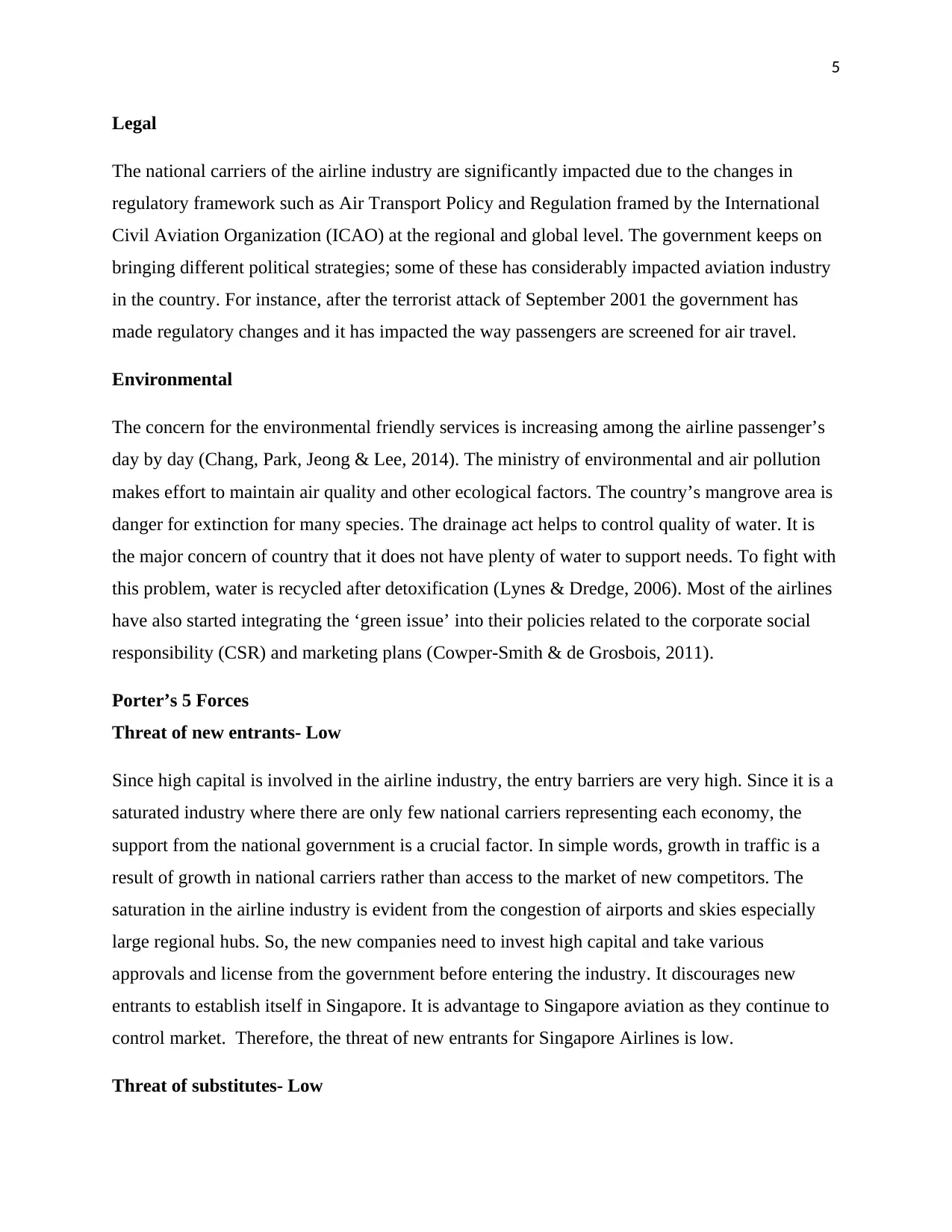
5
Legal
The national carriers of the airline industry are significantly impacted due to the changes in
regulatory framework such as Air Transport Policy and Regulation framed by the International
Civil Aviation Organization (ICAO) at the regional and global level. The government keeps on
bringing different political strategies; some of these has considerably impacted aviation industry
in the country. For instance, after the terrorist attack of September 2001 the government has
made regulatory changes and it has impacted the way passengers are screened for air travel.
Environmental
The concern for the environmental friendly services is increasing among the airline passenger’s
day by day (Chang, Park, Jeong & Lee, 2014). The ministry of environmental and air pollution
makes effort to maintain air quality and other ecological factors. The country’s mangrove area is
danger for extinction for many species. The drainage act helps to control quality of water. It is
the major concern of country that it does not have plenty of water to support needs. To fight with
this problem, water is recycled after detoxification (Lynes & Dredge, 2006). Most of the airlines
have also started integrating the ‘green issue’ into their policies related to the corporate social
responsibility (CSR) and marketing plans (Cowper-Smith & de Grosbois, 2011).
Porter’s 5 Forces
Threat of new entrants- Low
Since high capital is involved in the airline industry, the entry barriers are very high. Since it is a
saturated industry where there are only few national carriers representing each economy, the
support from the national government is a crucial factor. In simple words, growth in traffic is a
result of growth in national carriers rather than access to the market of new competitors. The
saturation in the airline industry is evident from the congestion of airports and skies especially
large regional hubs. So, the new companies need to invest high capital and take various
approvals and license from the government before entering the industry. It discourages new
entrants to establish itself in Singapore. It is advantage to Singapore aviation as they continue to
control market. Therefore, the threat of new entrants for Singapore Airlines is low.
Threat of substitutes- Low
Legal
The national carriers of the airline industry are significantly impacted due to the changes in
regulatory framework such as Air Transport Policy and Regulation framed by the International
Civil Aviation Organization (ICAO) at the regional and global level. The government keeps on
bringing different political strategies; some of these has considerably impacted aviation industry
in the country. For instance, after the terrorist attack of September 2001 the government has
made regulatory changes and it has impacted the way passengers are screened for air travel.
Environmental
The concern for the environmental friendly services is increasing among the airline passenger’s
day by day (Chang, Park, Jeong & Lee, 2014). The ministry of environmental and air pollution
makes effort to maintain air quality and other ecological factors. The country’s mangrove area is
danger for extinction for many species. The drainage act helps to control quality of water. It is
the major concern of country that it does not have plenty of water to support needs. To fight with
this problem, water is recycled after detoxification (Lynes & Dredge, 2006). Most of the airlines
have also started integrating the ‘green issue’ into their policies related to the corporate social
responsibility (CSR) and marketing plans (Cowper-Smith & de Grosbois, 2011).
Porter’s 5 Forces
Threat of new entrants- Low
Since high capital is involved in the airline industry, the entry barriers are very high. Since it is a
saturated industry where there are only few national carriers representing each economy, the
support from the national government is a crucial factor. In simple words, growth in traffic is a
result of growth in national carriers rather than access to the market of new competitors. The
saturation in the airline industry is evident from the congestion of airports and skies especially
large regional hubs. So, the new companies need to invest high capital and take various
approvals and license from the government before entering the industry. It discourages new
entrants to establish itself in Singapore. It is advantage to Singapore aviation as they continue to
control market. Therefore, the threat of new entrants for Singapore Airlines is low.
Threat of substitutes- Low
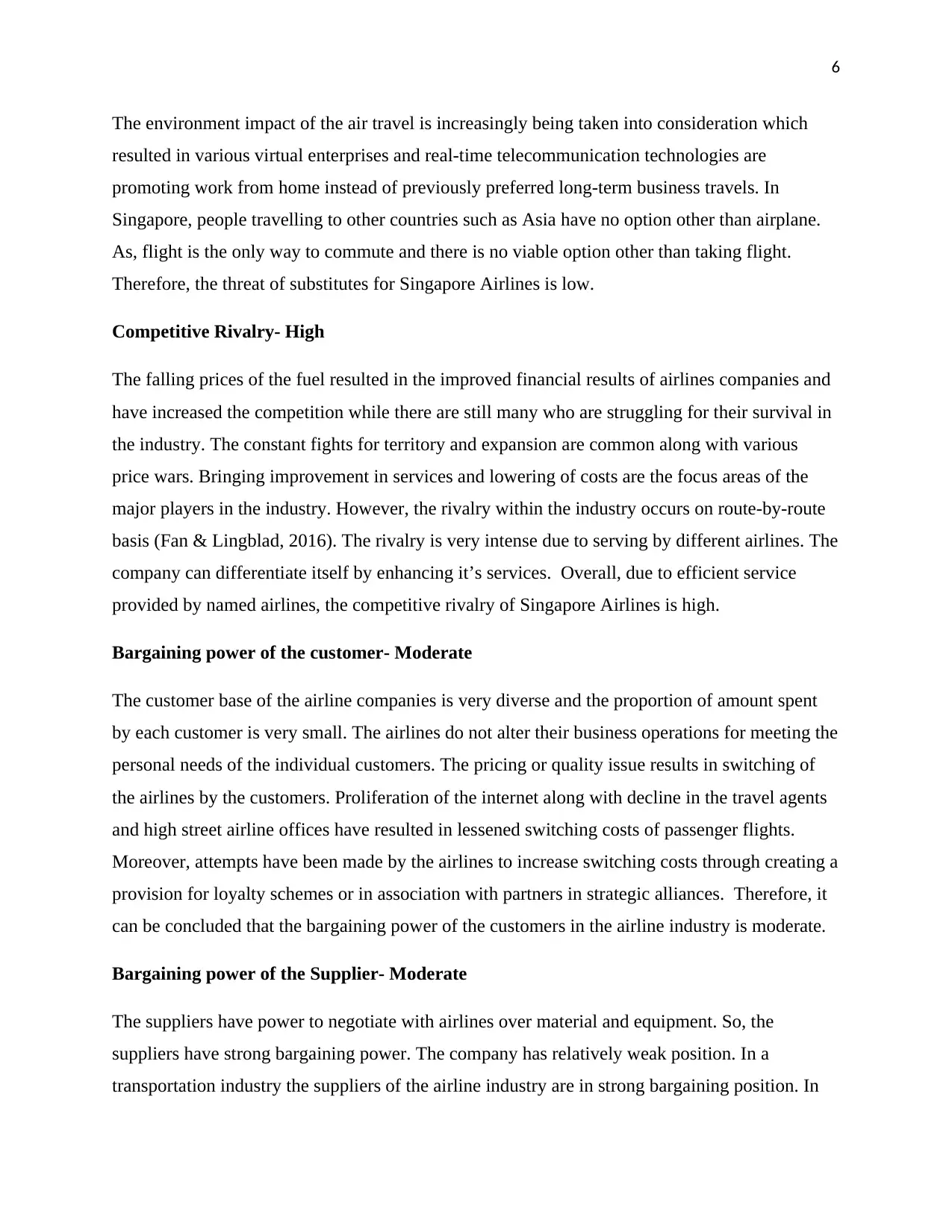
6
The environment impact of the air travel is increasingly being taken into consideration which
resulted in various virtual enterprises and real-time telecommunication technologies are
promoting work from home instead of previously preferred long-term business travels. In
Singapore, people travelling to other countries such as Asia have no option other than airplane.
As, flight is the only way to commute and there is no viable option other than taking flight.
Therefore, the threat of substitutes for Singapore Airlines is low.
Competitive Rivalry- High
The falling prices of the fuel resulted in the improved financial results of airlines companies and
have increased the competition while there are still many who are struggling for their survival in
the industry. The constant fights for territory and expansion are common along with various
price wars. Bringing improvement in services and lowering of costs are the focus areas of the
major players in the industry. However, the rivalry within the industry occurs on route-by-route
basis (Fan & Lingblad, 2016). The rivalry is very intense due to serving by different airlines. The
company can differentiate itself by enhancing it’s services. Overall, due to efficient service
provided by named airlines, the competitive rivalry of Singapore Airlines is high.
Bargaining power of the customer- Moderate
The customer base of the airline companies is very diverse and the proportion of amount spent
by each customer is very small. The airlines do not alter their business operations for meeting the
personal needs of the individual customers. The pricing or quality issue results in switching of
the airlines by the customers. Proliferation of the internet along with decline in the travel agents
and high street airline offices have resulted in lessened switching costs of passenger flights.
Moreover, attempts have been made by the airlines to increase switching costs through creating a
provision for loyalty schemes or in association with partners in strategic alliances. Therefore, it
can be concluded that the bargaining power of the customers in the airline industry is moderate.
Bargaining power of the Supplier- Moderate
The suppliers have power to negotiate with airlines over material and equipment. So, the
suppliers have strong bargaining power. The company has relatively weak position. In a
transportation industry the suppliers of the airline industry are in strong bargaining position. In
The environment impact of the air travel is increasingly being taken into consideration which
resulted in various virtual enterprises and real-time telecommunication technologies are
promoting work from home instead of previously preferred long-term business travels. In
Singapore, people travelling to other countries such as Asia have no option other than airplane.
As, flight is the only way to commute and there is no viable option other than taking flight.
Therefore, the threat of substitutes for Singapore Airlines is low.
Competitive Rivalry- High
The falling prices of the fuel resulted in the improved financial results of airlines companies and
have increased the competition while there are still many who are struggling for their survival in
the industry. The constant fights for territory and expansion are common along with various
price wars. Bringing improvement in services and lowering of costs are the focus areas of the
major players in the industry. However, the rivalry within the industry occurs on route-by-route
basis (Fan & Lingblad, 2016). The rivalry is very intense due to serving by different airlines. The
company can differentiate itself by enhancing it’s services. Overall, due to efficient service
provided by named airlines, the competitive rivalry of Singapore Airlines is high.
Bargaining power of the customer- Moderate
The customer base of the airline companies is very diverse and the proportion of amount spent
by each customer is very small. The airlines do not alter their business operations for meeting the
personal needs of the individual customers. The pricing or quality issue results in switching of
the airlines by the customers. Proliferation of the internet along with decline in the travel agents
and high street airline offices have resulted in lessened switching costs of passenger flights.
Moreover, attempts have been made by the airlines to increase switching costs through creating a
provision for loyalty schemes or in association with partners in strategic alliances. Therefore, it
can be concluded that the bargaining power of the customers in the airline industry is moderate.
Bargaining power of the Supplier- Moderate
The suppliers have power to negotiate with airlines over material and equipment. So, the
suppliers have strong bargaining power. The company has relatively weak position. In a
transportation industry the suppliers of the airline industry are in strong bargaining position. In
Paraphrase This Document
Need a fresh take? Get an instant paraphrase of this document with our AI Paraphraser
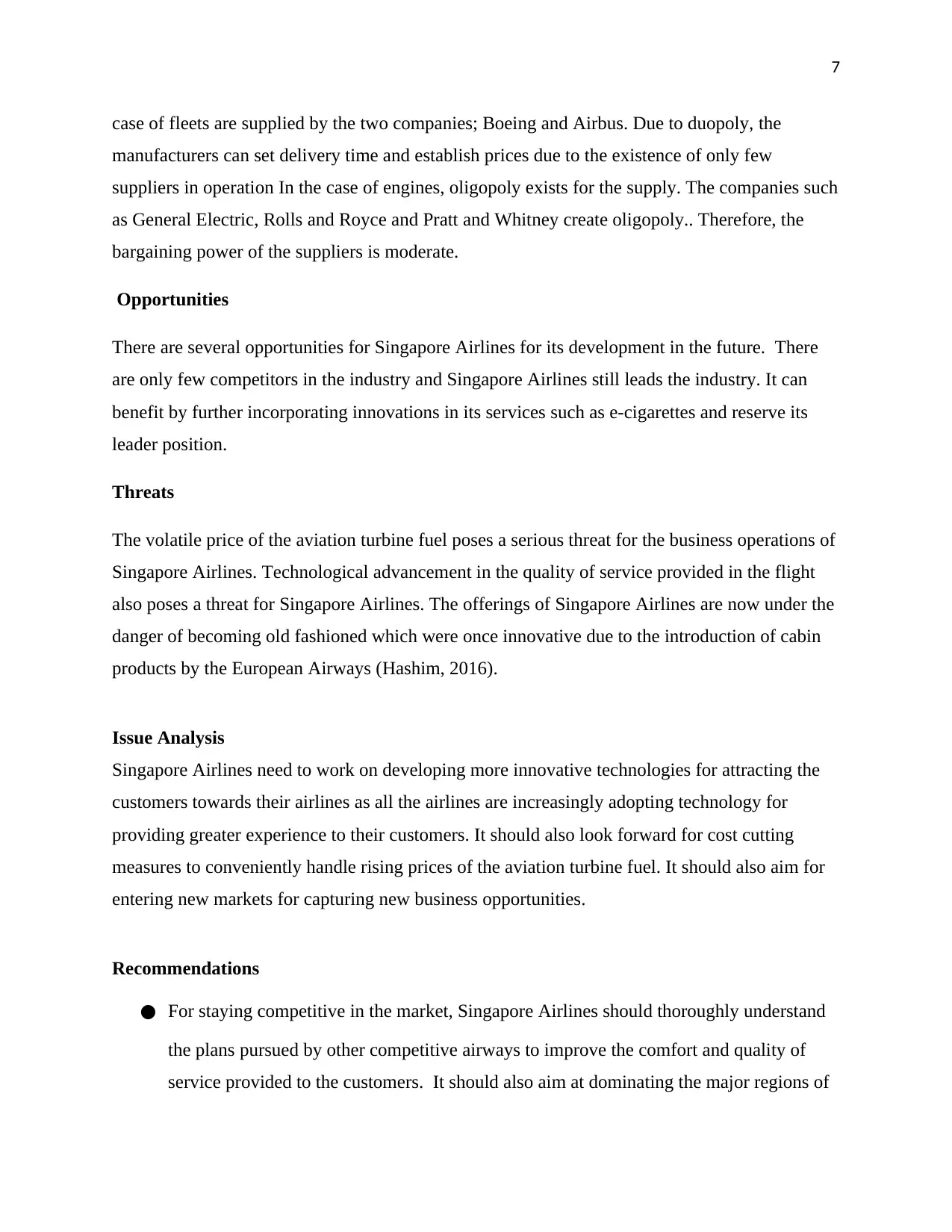
7
case of fleets are supplied by the two companies; Boeing and Airbus. Due to duopoly, the
manufacturers can set delivery time and establish prices due to the existence of only few
suppliers in operation In the case of engines, oligopoly exists for the supply. The companies such
as General Electric, Rolls and Royce and Pratt and Whitney create oligopoly.. Therefore, the
bargaining power of the suppliers is moderate.
Opportunities
There are several opportunities for Singapore Airlines for its development in the future. There
are only few competitors in the industry and Singapore Airlines still leads the industry. It can
benefit by further incorporating innovations in its services such as e-cigarettes and reserve its
leader position.
Threats
The volatile price of the aviation turbine fuel poses a serious threat for the business operations of
Singapore Airlines. Technological advancement in the quality of service provided in the flight
also poses a threat for Singapore Airlines. The offerings of Singapore Airlines are now under the
danger of becoming old fashioned which were once innovative due to the introduction of cabin
products by the European Airways (Hashim, 2016).
Issue Analysis
Singapore Airlines need to work on developing more innovative technologies for attracting the
customers towards their airlines as all the airlines are increasingly adopting technology for
providing greater experience to their customers. It should also look forward for cost cutting
measures to conveniently handle rising prices of the aviation turbine fuel. It should also aim for
entering new markets for capturing new business opportunities.
Recommendations
● For staying competitive in the market, Singapore Airlines should thoroughly understand
the plans pursued by other competitive airways to improve the comfort and quality of
service provided to the customers. It should also aim at dominating the major regions of
case of fleets are supplied by the two companies; Boeing and Airbus. Due to duopoly, the
manufacturers can set delivery time and establish prices due to the existence of only few
suppliers in operation In the case of engines, oligopoly exists for the supply. The companies such
as General Electric, Rolls and Royce and Pratt and Whitney create oligopoly.. Therefore, the
bargaining power of the suppliers is moderate.
Opportunities
There are several opportunities for Singapore Airlines for its development in the future. There
are only few competitors in the industry and Singapore Airlines still leads the industry. It can
benefit by further incorporating innovations in its services such as e-cigarettes and reserve its
leader position.
Threats
The volatile price of the aviation turbine fuel poses a serious threat for the business operations of
Singapore Airlines. Technological advancement in the quality of service provided in the flight
also poses a threat for Singapore Airlines. The offerings of Singapore Airlines are now under the
danger of becoming old fashioned which were once innovative due to the introduction of cabin
products by the European Airways (Hashim, 2016).
Issue Analysis
Singapore Airlines need to work on developing more innovative technologies for attracting the
customers towards their airlines as all the airlines are increasingly adopting technology for
providing greater experience to their customers. It should also look forward for cost cutting
measures to conveniently handle rising prices of the aviation turbine fuel. It should also aim for
entering new markets for capturing new business opportunities.
Recommendations
● For staying competitive in the market, Singapore Airlines should thoroughly understand
the plans pursued by other competitive airways to improve the comfort and quality of
service provided to the customers. It should also aim at dominating the major regions of

8
the globe for creating greater potential for foreign investments which in turn will allow
Singapore Airlines to withstand their quality efforts (Heracleous & Wirtz, 2012).
● It should also employ some cost cutting measures for the purpose of reducing the fleet
size and selling the excess aircrafts to the other low-cost carriers that are currently at the
phase of expansion (Schofield, 2016). Cost can be reduced by cancelling those processes
that does not contribute towards the profitability of airlines. The cost cutting measures
will help Singapore Airlines in managing the volatile prices of aviation turbine fuel and
diversifying risks (Kaynak & Kucukemiroglu, 2015).
● It should also work on creating service excellence by way of looking into the manner in
which the front-line staff fosters relationship with their customers in order to create
personalized service such that it can be easily differentiated from its competitors (Wirtz,
Heracleous & Pangarkar, 2008). It will help in staying competitive in the market and
providing better comfort and services to the customers. For this purpose, space beds
should be installed. E-cigarettes facility can be provided which will create the feeling of
tobacco smoking on airplane. Also, for establishing better relationships with the business
class customers, same or higher value comfort should be offered. Installation of space
beds and e- cigarettes will also increase the revenue of Singapore Airlines in the long run
as it will result in higher utilization of the seats.
Conclusion
This report highlighted the micro and macro environment of Singapore Airline Limited which
faces various opportunities and threats due to the presence of various elements in the
environment depending upon the presence of competitors, number of suppliers, new entrants,
substitutes, etc. The analysis of external environment of Singapore Airlines Limited highlights
that it needs to focus on innovative technologies for enhancing the experience of the customers
on the flights. Moreover, some cost cutting measures are required for meeting any risks in
operations along with meeting the fluctuations in prices of aviation turbine fuel.
the globe for creating greater potential for foreign investments which in turn will allow
Singapore Airlines to withstand their quality efforts (Heracleous & Wirtz, 2012).
● It should also employ some cost cutting measures for the purpose of reducing the fleet
size and selling the excess aircrafts to the other low-cost carriers that are currently at the
phase of expansion (Schofield, 2016). Cost can be reduced by cancelling those processes
that does not contribute towards the profitability of airlines. The cost cutting measures
will help Singapore Airlines in managing the volatile prices of aviation turbine fuel and
diversifying risks (Kaynak & Kucukemiroglu, 2015).
● It should also work on creating service excellence by way of looking into the manner in
which the front-line staff fosters relationship with their customers in order to create
personalized service such that it can be easily differentiated from its competitors (Wirtz,
Heracleous & Pangarkar, 2008). It will help in staying competitive in the market and
providing better comfort and services to the customers. For this purpose, space beds
should be installed. E-cigarettes facility can be provided which will create the feeling of
tobacco smoking on airplane. Also, for establishing better relationships with the business
class customers, same or higher value comfort should be offered. Installation of space
beds and e- cigarettes will also increase the revenue of Singapore Airlines in the long run
as it will result in higher utilization of the seats.
Conclusion
This report highlighted the micro and macro environment of Singapore Airline Limited which
faces various opportunities and threats due to the presence of various elements in the
environment depending upon the presence of competitors, number of suppliers, new entrants,
substitutes, etc. The analysis of external environment of Singapore Airlines Limited highlights
that it needs to focus on innovative technologies for enhancing the experience of the customers
on the flights. Moreover, some cost cutting measures are required for meeting any risks in
operations along with meeting the fluctuations in prices of aviation turbine fuel.
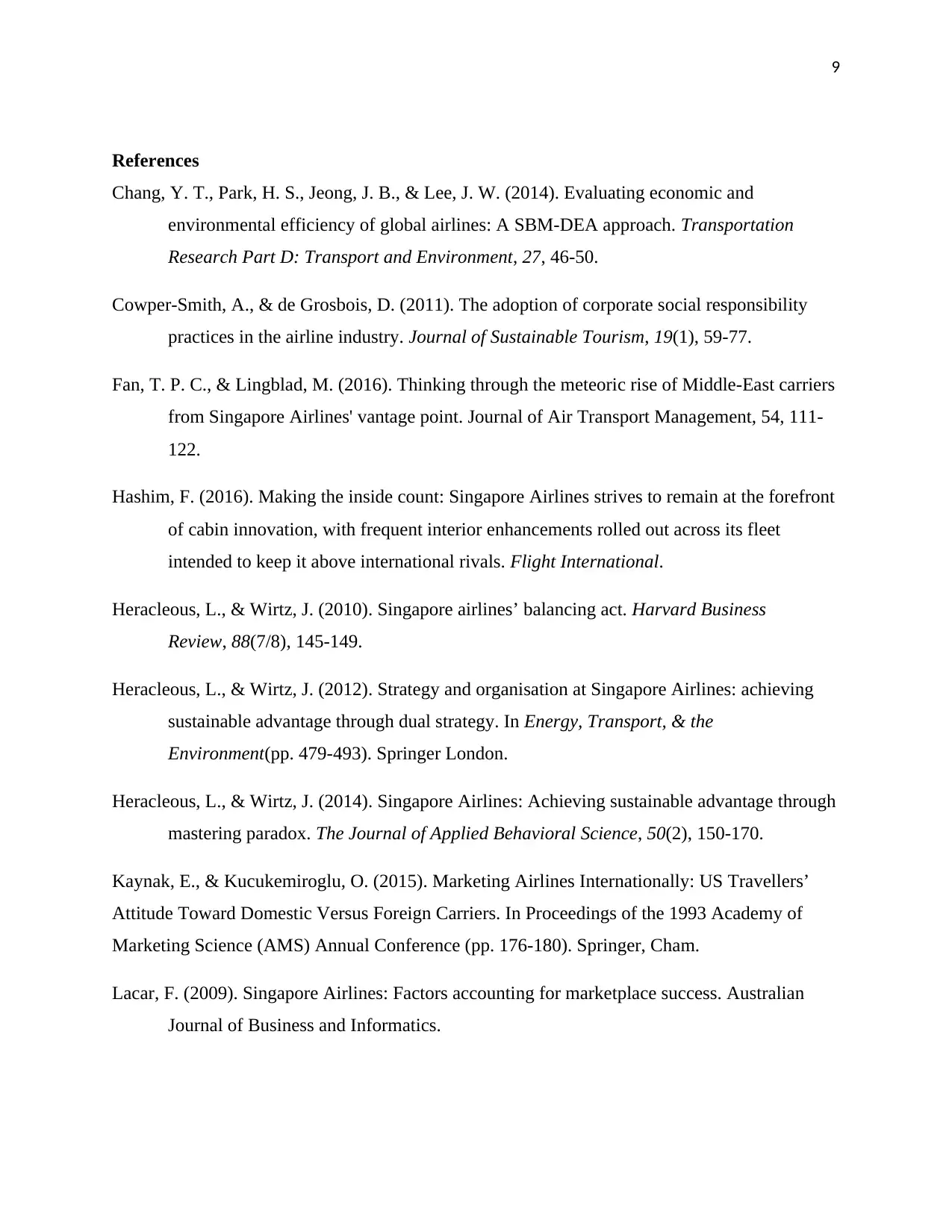
9
References
Chang, Y. T., Park, H. S., Jeong, J. B., & Lee, J. W. (2014). Evaluating economic and
environmental efficiency of global airlines: A SBM-DEA approach. Transportation
Research Part D: Transport and Environment, 27, 46-50.
Cowper-Smith, A., & de Grosbois, D. (2011). The adoption of corporate social responsibility
practices in the airline industry. Journal of Sustainable Tourism, 19(1), 59-77.
Fan, T. P. C., & Lingblad, M. (2016). Thinking through the meteoric rise of Middle-East carriers
from Singapore Airlines' vantage point. Journal of Air Transport Management, 54, 111-
122.
Hashim, F. (2016). Making the inside count: Singapore Airlines strives to remain at the forefront
of cabin innovation, with frequent interior enhancements rolled out across its fleet
intended to keep it above international rivals. Flight International.
Heracleous, L., & Wirtz, J. (2010). Singapore airlines’ balancing act. Harvard Business
Review, 88(7/8), 145-149.
Heracleous, L., & Wirtz, J. (2012). Strategy and organisation at Singapore Airlines: achieving
sustainable advantage through dual strategy. In Energy, Transport, & the
Environment(pp. 479-493). Springer London.
Heracleous, L., & Wirtz, J. (2014). Singapore Airlines: Achieving sustainable advantage through
mastering paradox. The Journal of Applied Behavioral Science, 50(2), 150-170.
Kaynak, E., & Kucukemiroglu, O. (2015). Marketing Airlines Internationally: US Travellers’
Attitude Toward Domestic Versus Foreign Carriers. In Proceedings of the 1993 Academy of
Marketing Science (AMS) Annual Conference (pp. 176-180). Springer, Cham.
Lacar, F. (2009). Singapore Airlines: Factors accounting for marketplace success. Australian
Journal of Business and Informatics.
References
Chang, Y. T., Park, H. S., Jeong, J. B., & Lee, J. W. (2014). Evaluating economic and
environmental efficiency of global airlines: A SBM-DEA approach. Transportation
Research Part D: Transport and Environment, 27, 46-50.
Cowper-Smith, A., & de Grosbois, D. (2011). The adoption of corporate social responsibility
practices in the airline industry. Journal of Sustainable Tourism, 19(1), 59-77.
Fan, T. P. C., & Lingblad, M. (2016). Thinking through the meteoric rise of Middle-East carriers
from Singapore Airlines' vantage point. Journal of Air Transport Management, 54, 111-
122.
Hashim, F. (2016). Making the inside count: Singapore Airlines strives to remain at the forefront
of cabin innovation, with frequent interior enhancements rolled out across its fleet
intended to keep it above international rivals. Flight International.
Heracleous, L., & Wirtz, J. (2010). Singapore airlines’ balancing act. Harvard Business
Review, 88(7/8), 145-149.
Heracleous, L., & Wirtz, J. (2012). Strategy and organisation at Singapore Airlines: achieving
sustainable advantage through dual strategy. In Energy, Transport, & the
Environment(pp. 479-493). Springer London.
Heracleous, L., & Wirtz, J. (2014). Singapore Airlines: Achieving sustainable advantage through
mastering paradox. The Journal of Applied Behavioral Science, 50(2), 150-170.
Kaynak, E., & Kucukemiroglu, O. (2015). Marketing Airlines Internationally: US Travellers’
Attitude Toward Domestic Versus Foreign Carriers. In Proceedings of the 1993 Academy of
Marketing Science (AMS) Annual Conference (pp. 176-180). Springer, Cham.
Lacar, F. (2009). Singapore Airlines: Factors accounting for marketplace success. Australian
Journal of Business and Informatics.
Secure Best Marks with AI Grader
Need help grading? Try our AI Grader for instant feedback on your assignments.
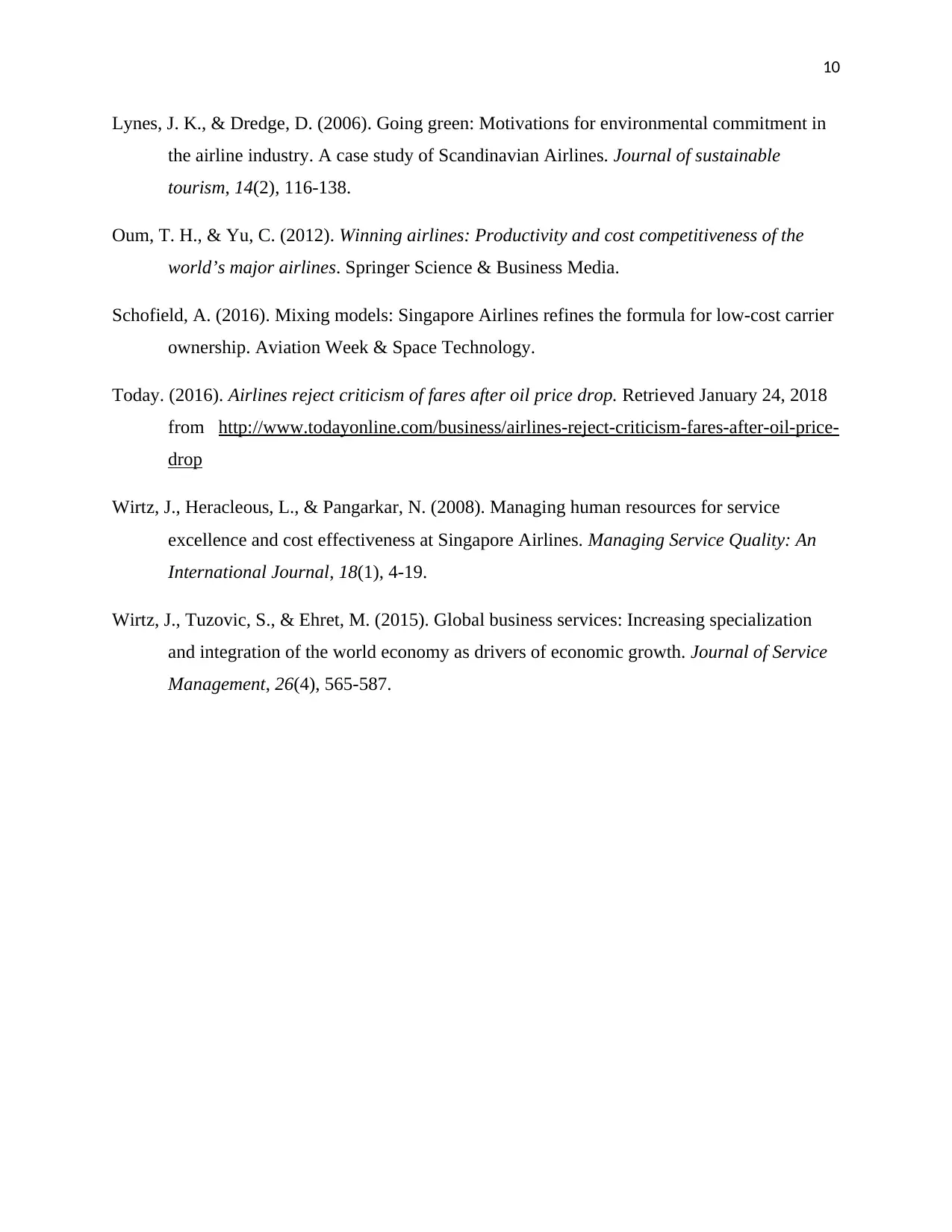
10
Lynes, J. K., & Dredge, D. (2006). Going green: Motivations for environmental commitment in
the airline industry. A case study of Scandinavian Airlines. Journal of sustainable
tourism, 14(2), 116-138.
Oum, T. H., & Yu, C. (2012). Winning airlines: Productivity and cost competitiveness of the
world’s major airlines. Springer Science & Business Media.
Schofield, A. (2016). Mixing models: Singapore Airlines refines the formula for low-cost carrier
ownership. Aviation Week & Space Technology.
Today. (2016). Airlines reject criticism of fares after oil price drop. Retrieved January 24, 2018
from http://www.todayonline.com/business/airlines-reject-criticism-fares-after-oil-price-
drop
Wirtz, J., Heracleous, L., & Pangarkar, N. (2008). Managing human resources for service
excellence and cost effectiveness at Singapore Airlines. Managing Service Quality: An
International Journal, 18(1), 4-19.
Wirtz, J., Tuzovic, S., & Ehret, M. (2015). Global business services: Increasing specialization
and integration of the world economy as drivers of economic growth. Journal of Service
Management, 26(4), 565-587.
Lynes, J. K., & Dredge, D. (2006). Going green: Motivations for environmental commitment in
the airline industry. A case study of Scandinavian Airlines. Journal of sustainable
tourism, 14(2), 116-138.
Oum, T. H., & Yu, C. (2012). Winning airlines: Productivity and cost competitiveness of the
world’s major airlines. Springer Science & Business Media.
Schofield, A. (2016). Mixing models: Singapore Airlines refines the formula for low-cost carrier
ownership. Aviation Week & Space Technology.
Today. (2016). Airlines reject criticism of fares after oil price drop. Retrieved January 24, 2018
from http://www.todayonline.com/business/airlines-reject-criticism-fares-after-oil-price-
drop
Wirtz, J., Heracleous, L., & Pangarkar, N. (2008). Managing human resources for service
excellence and cost effectiveness at Singapore Airlines. Managing Service Quality: An
International Journal, 18(1), 4-19.
Wirtz, J., Tuzovic, S., & Ehret, M. (2015). Global business services: Increasing specialization
and integration of the world economy as drivers of economic growth. Journal of Service
Management, 26(4), 565-587.
1 out of 11
Related Documents
Your All-in-One AI-Powered Toolkit for Academic Success.
+13062052269
info@desklib.com
Available 24*7 on WhatsApp / Email
![[object Object]](/_next/static/media/star-bottom.7253800d.svg)
Unlock your academic potential
© 2024 | Zucol Services PVT LTD | All rights reserved.





